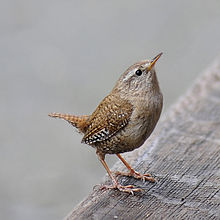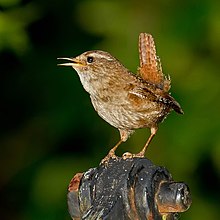
Back Zaunkönig ALS Troglodytes troglodytes AN صعو أوراسي Arabic صعو اوراسى ARZ Troglodytes troglodytes AST Кесерткән турғайы Bashkir Pfutscher BAR Крапіўнік Byelorussian Орехче Bulgarian Laouenan troc'hanik Breton
| Eurasian wren | |
|---|---|

| |
| Nominate subspecies in North Rhine-Westphalia, Germany
| |
| Scientific classification | |
| Domain: | Eukaryota |
| Kingdom: | Animalia |
| Phylum: | Chordata |
| Class: | Aves |
| Order: | Passeriformes |
| Family: | Troglodytidae |
| Genus: | Troglodytes |
| Species: | T. troglodytes
|
| Binomial name | |
| Troglodytes troglodytes | |

| |
Breeding summer visitor
Breeding resident
Non-breeding winter visitor
| |
| Synonyms | |
| |
The Eurasian wren (Troglodytes troglodytes) or northern wren is a very small insectivorous bird, and the only member of the wren family Troglodytidae found in Eurasia and Africa (Maghreb). In Anglophone Europe, it is commonly known simply as the wren. It has a very short tail which is often held erect, a short neck and a relatively long thin bill. It is russet brown above, paler buff-brown below and has a cream buff supercilium. The sexes are alike.
The species was once lumped with Troglodytes hiemalis of eastern North America and Troglodytes pacificus of western North America as the winter wren. The Eurasian wren occurs in Europe and across the Palearctic – including a belt of Asia from northern Iran and Afghanistan across to Japan. It is migratory in only the northern parts of its range.[3] It is also highly polygynous, an unusual mating system for passerines.

The scientific name is taken from the Greek word "troglodytes" (from τρώγλη troglē "hole", and δῠ́ειν dyein, "creep"), meaning "hole-dweller", and refers to its habit of disappearing into cavities or crevices whilst hunting arthropods or to roost. The taxonomy of the genus Troglodytes is currently unresolved, as recent molecular studies have suggested that Cistothorus spp. and Thryorchilus spp. are within the clade currently defined by Troglodytes.[4][5]
- ^ BirdLife International. (2018). "Troglodytes troglodytes". IUCN Red List of Threatened Species. 2018: e.T103883277A132200296. doi:10.2305/IUCN.UK.2018-2.RLTS.T103883277A132200296.en. Retrieved 9 June 2021.
- ^ Mayr, Ernst; Greenway, James C. Jr, eds. (1960). Check-list of Birds of the World. Vol. 9. Cambridge, Massachusetts: Museum of Comparative Zoology. p. 421.
- ^ Brewer, David; Mackay, Barry Kent (2001). Wrens, Dippers and Thrashers. Christopher Helm. ISBN 1-873403-95-X.
- ^ Rice, Nathan H.; Peterson, A. Townsend; Escalona-Segura, Griselda (1999). "Phylogenetic patterns in montane Troglodytes wrens" (PDF). The Condor. 101 (2): 446–451. doi:10.2307/1370013. hdl:1808/16635. JSTOR 1370013.
- ^ Martínez Gómez, Juan E.; Barber, Bruian R.; Peterson, A. Townsend (2005). "Phylogenetic position and generic placement of the Socorro Wren (Thryomanes sissonii)". Auk. 12 (1): 50–56. doi:10.1642/0004-8038(2005)122[0050:PPAGPO]2.0.CO;2. hdl:1808/16612.
© MMXXIII Rich X Search. We shall prevail. All rights reserved. Rich X Search
